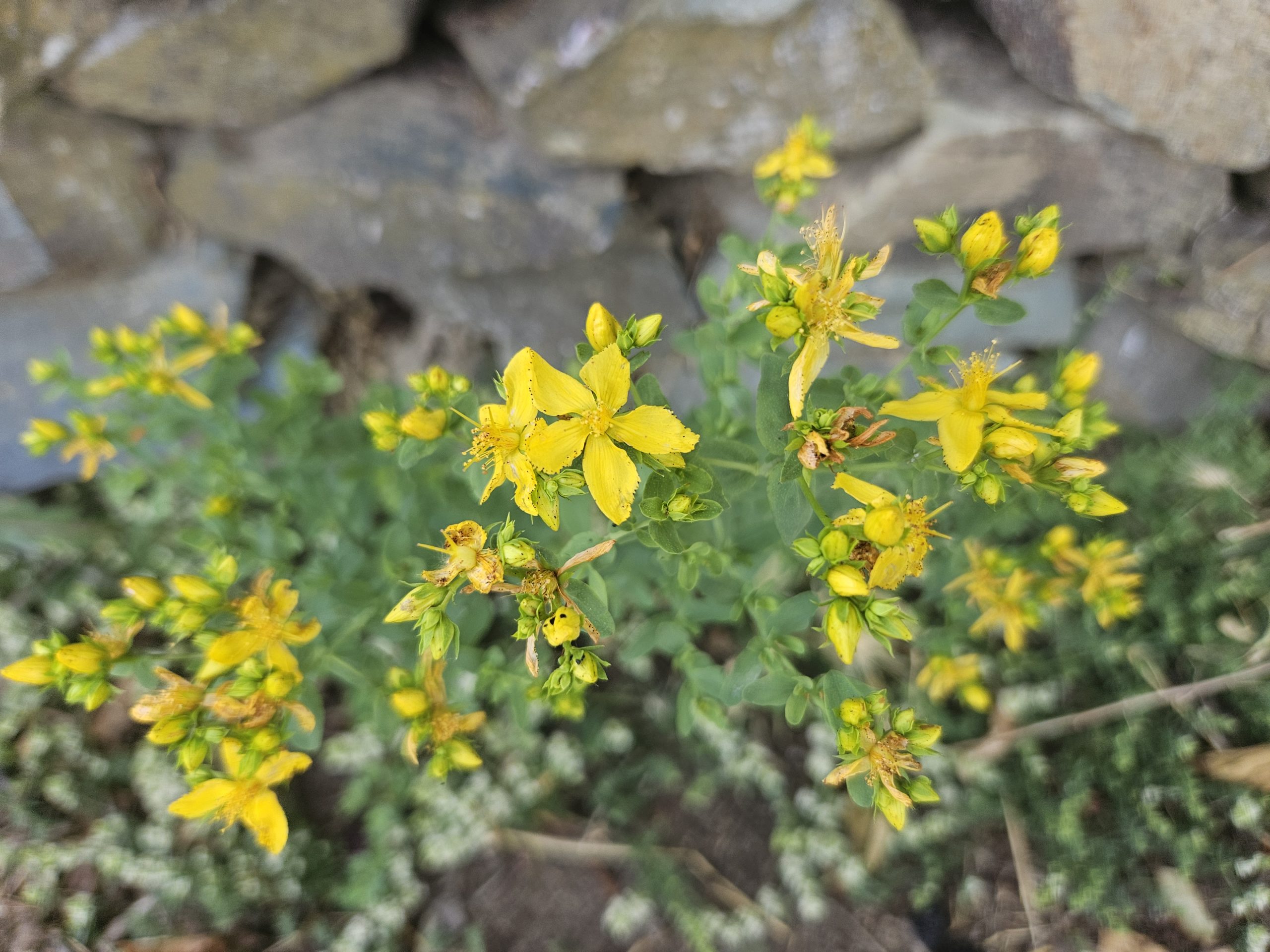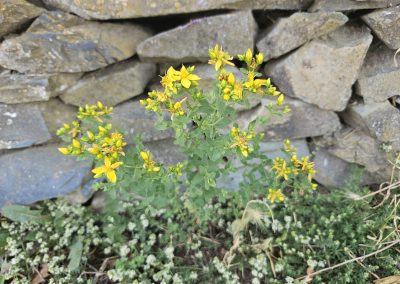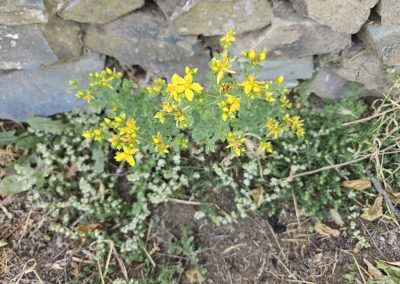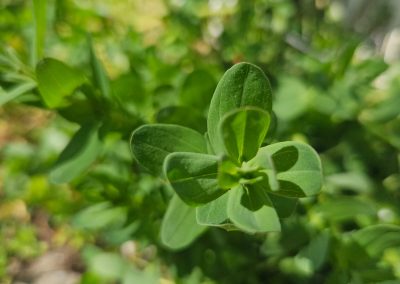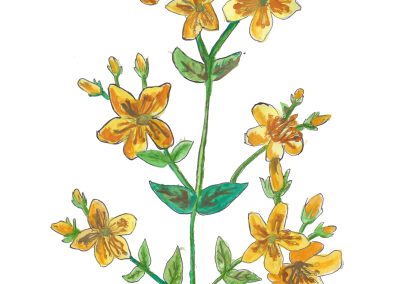Hypericum perforatum
Scientific description
Phylum: Angiospermatophyta (Magnoliophyta)
Class: Dicotyledonatae (Magnoliatae)
Subclass: Dilleniidae
Order: Theales
Family: Hypericaceae
Origin: worldwide species.
Common name: St. John's Wort
Description:
It is a herbaceous, perennial plant up to 1 meter tall, with a shallow rhizome and well-developed roots. The stem is straight, cylindrical, woody at the base, with two long edges marked with black hypericin dots, branching at the top. Leaves are opposite, sessile, oval, glabrous, with entire margins and secretory pouches containing volatile oils, giving a translucent effect. Flowers are terminal in complex cymose inflorescences, hermaphroditic, pentamerous, with five elongated, glabrous sepals, five golden-yellow petals with black dots, numerous stamens, and a green, sticky ovary protruding beyond the sepals. Flowering occurs from June to September. Fruit is an oval capsule.
Propagation: by seed at physiological maturity.
Ecology:
Common spontaneous species from lowlands to mountains, along roadsides, forest edges, and uncultivated land. Prefers sunny locations, calcareous or siliceous soils, drought and frost resistant.
Uses:
Pharmaceutical plant rich in hypericin, volatile oils, tannins, and caffeic acid. Flowering parts with leaves and branches are used. Teas for liver disorders, increase bile secretion; also antiseptic, astringent, antidepressant, antiviral, and healing.
Hazard: widely used in teas.
Încrengătura: Angiospermatophyta (Magnoliophyta)
Clasa: Dicotyledonatae (Magnoliatae)
Subclasa: Dilleniidae
Ordinul: Theales
Familia: Hypericaceae
Origine: specie răspândită la nivel mondial.
Denumire populară: Sunătoare
Descriere:
Plantă ierboasă perenă, până la 1 m, cu rizom superficial și rădăcini bine dezvoltate. Tulpina dreaptă, cilindrică, lemnoasă la bază, cu două muchii cu puncte negre de hipericină, ramificată la vârf. Frunzele sunt opuse, sesile, ovale, glabre, cu margini întregi și buzunare secretoare cu ulei volatil, dând aspect translucid. Florile terminale, în inflorescențe cimoase complexe, hermafrodite, pentamere, cu cinci sepale lungi, glabre, cinci petale galben-aurii cu puncte negre, stamine numeroase, ovar verde și lipicios depășind sepalele. Înflorește iunie–septembrie. Fructul este o capsulă ovală.
Înmulțire: prin semințe la maturitatea fiziologică.
Ecologie:
Specie comună, spontană, de la câmpie la munte, pe marginea drumurilor, la păduri și terenuri neîngrijite. Preferă locuri însorite, sol calcaros sau silicios; rezistentă la secetă și îngheț.
Utilizare:
Plantă cu valoare farmaceutică, bogată în hipericină, uleiuri volatile, taninuri și acid cafeic. Se folosesc părțile înflorite cu frunze și ramuri. Ceaiuri pentru afecțiuni hepatice, crește secreția biliară; antiseptic, astringent, antidepresiv, antiviral și cicatrizant.
Pericol: utilizată pe scară largă pentru ceaiuri.
Φύλο: Αγγειόσπερμα (Magnoliophyta)
Κλάση: Δικοτυλήδονα (Magnoliatae)
Υποκλάση: Dilleniidae
Τάξη: Theales
Οικογένεια: Hypericaceae
Καταγωγή: παγκοσμίως
Δημοφιλής ονομασία: Βαλσαμόχορτο
Περιγραφή:
Πολυετές ποώδες φυτό ύψους έως 1 μ., με ρηχό ριζικό σύστημα και καλά αναπτυγμένες ρίζες. Βλαστός ίσιος, κυλινδρικός, ξυλώδης στη βάση, δύο ακμές με μαύρες κουκκίδες υπερικίνης, διακλαδισμένος στην κορυφή. Φύλλα αντίθετα, άμισχα, οβάλ, γυαλιστερά, με ολόκληρα χείλη και εκκριτικά θυλάκια. Άνθη τερματικά, σε σύνθετες κυμοειδείς ταξιανθίες, ερμαφρόδιτα, πενταμερή. Πέταλα πέντε χρυσό-κίτρινα με μαύρες κουκκίδες, πολυάριθμοι στήμονες, πράσινο κολλώδες ωάριο προεξέχει. Ανθίζει Ιούνιο–Σεπτέμβριο. Καρπός: οβάλ κάψα.
Πολλαπλασιασμός: με σπόρους μόλις ωριμάσει ο καρπός.
Οικολογία:
Αυτοφύεται από πεδιάδες έως βουνά, δίπλα σε δρόμους, στα όρια δασών και σε εγκαταλελειμμένα εδάφη. Προτιμά ηλιόλουστες, ασβεστολιθικές ή πυριτικές περιοχές.
Χρήση:
Φαρμακευτική αξία: πλούσιο σε υπερικίνη, αιθέρια έλαια, τανίνες και καφεϊκό οξύ. Χρησιμοποιούνται τα ανθισμένα μέρη με φύλλα και κλαδιά. Τσάι για ηπατικές παθήσεις, αυξάνει έκκριση χολής. Αντισηπτικό, στυπτικό, αντικαταθλιπτικό, αντιιικό και επουλωτικό.
Κίνδυνος: ευρέως χρησιμοποιούμενο για τσάι.
Embranchement : Angiospermatophyta (Magnoliophyta)
Classe : Dicotylédones (Magnoliatae)
Sous-classe : Dilleniidae
Ordre : Theales
Famille : Hypericaceae
Origine : espèce mondiale
Nom commun : Millepertuis
Description :
Plante herbacée vivace jusqu’à 1 m, rhizome peu profond avec racines bien développées. Tige droite, cylindrique, ligneuse à la base, deux arêtes avec points noirs d’hypéricine, ramifiée au sommet. Feuilles opposées, sessiles, ovales, glabres, bords entiers, poches sécrétrices avec huile volatile. Fleurs terminales, inflorescences cymoïdes complexes, hermaphrodites, pentamères. Cinq sépales allongés glabres, cinq pétales jaune-doré avec points noirs, nombreux étamines, ovaire vert collant dépassant les sépales. Floraison juin–septembre. Fruit: capsule ovale.
Multiplication : par graines à maturité physiologique.
Écologie :
Espèce commune spontanée, de la plaine à la montagne, au bord des routes, lisières de forêts et terrains incultes. Préfère lieux ensoleillés, sols calcaires ou siliceux.
Utilisation :
Plante pharmaceutique, riche en hypericine, huiles volatiles, tanins et acide caféique. Parties fleuries utilisées avec feuilles et branches. Infusions pour affections hépatiques, augmente sécrétion biliaire; antiseptique, astringent, antidépresseur, antiviral et cicatrisant.
Remarque: largement utilisée pour les infusions.
Creative writing inspired by Hypericum perforatum
Written by Pop Loredana-Aurelia
The Legend of Hypericum: The Sun’s Secret Remedy
Long ago, in a time when the gods still roamed the earth, there was a mighty Titan named Hyperion. He was the father of the dawn, the sun, and the moon, and his very presence brought light and life to the world. Hyperion's wife, Theia, bore him a son, Helios, the radiant God of the Sun. Helios was often depicted wearing a crown made of golden rays, shining brightly as he drove his fiery chariot across the sky each day.
But it was not just the godly light that Hyperion wielded. His own essence was tied to the very forces of nature, especially the brilliance of the sun and its healing power. It is said that one day, as Hyperion walked across the heavens, he left behind a gift for the mortal world—a humble yet radiant plant. Its leaves, dotted with small holes, let light shine through as though they were a reflection of the sun's rays. Its flowers bloomed bright yellow, capturing the very essence of sunlight, bringing with it warmth and healing power.
As centuries passed, the plant grew known to those who sought its benefits. The great Greek physician Dioscorides, known as the father of pharmacognosy, wrote about it in his famed work, De Materia Medica, around 500 AD. He explained that the plant’s Latin name, Hypericum Perforatum, was derived from the words hyper eikon, meaning "exceeding any imagination." It was no wonder, for this plant had many magical and medicinal properties. The emperor, Nero, was known to consume it daily, convinced that it would protect him from poisoning.
However, as the centuries marched on, Hypericum’s name and properties began to fade into the shadows of forgotten history, overshadowed by the rise of new discoveries. But like many ancient wonders, it was destined to be rediscovered in the future.
Fast forward to a time when Christianity had spread far and wide across the lands. The solstice, which had once been tied to the sun’s cycle, now became associated with Saint John the Baptist. As fate would have it, the very plant that had once shone with the sun’s light began to bloom around the same time that Saint John’s feast day arrived. It seemed like a sign from the heavens, and the people began to connect the two.
This plant, with its vibrant yellow flowers and the red liquid that seeped from its stem when crushed, was now viewed with deep reverence. The red liquid, they believed, was a symbol of Saint John’s blood, and they began to associate the plant with his martyrdom. And so, the plant—now known as Fuga Demonium or "The Devil’s Flight"—became known as a divine gift. The people believed that its power was a secret hidden by God, meant to protect humans from dark forces. It was said that the plant could rid the body of demons and alleviate emotional suffering, soothing the soul with its natural power.
In the Middle Ages, it became a tool in exorcisms, with priests using its branches and flowers to banish evil spirits. The plant was seen as a sacred ally in the battle against darkness. Its healing properties spread far and wide, as it was believed to relieve both physical and psychological pains. Those who had access to Hypericum were blessed, for it had the ability to heal wounds of the heart and mind.
And even today, the humble plant remains a source of comfort and healing. Hypericum, with its radiant yellow blooms, still offers its gifts to those who seek them. Whether in the form of an herbal remedy for inner and outer pains, or as a symbol of the sun’s eternal power to heal, Hypericum’s legacy endures.
It is said that the sun’s essence, captured in the flowers of Hypericum, still shines brightly for those who know where to look. And in every petal, there is a reminder of the legends that have passed through time—of Hyperion’s gift to the earth, of Saint John’s sacrifice, and of the light that never fades.
For as long as the sun rises and sets, the Hypericum Perforatum will bloom, offering its light and healing to all who need it.


